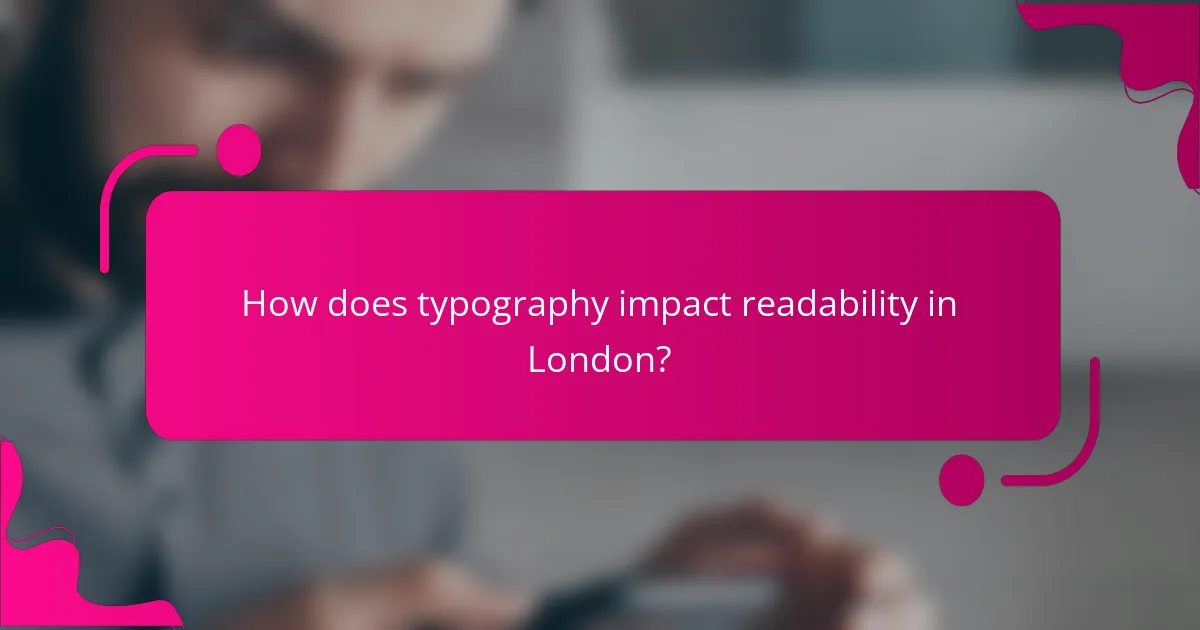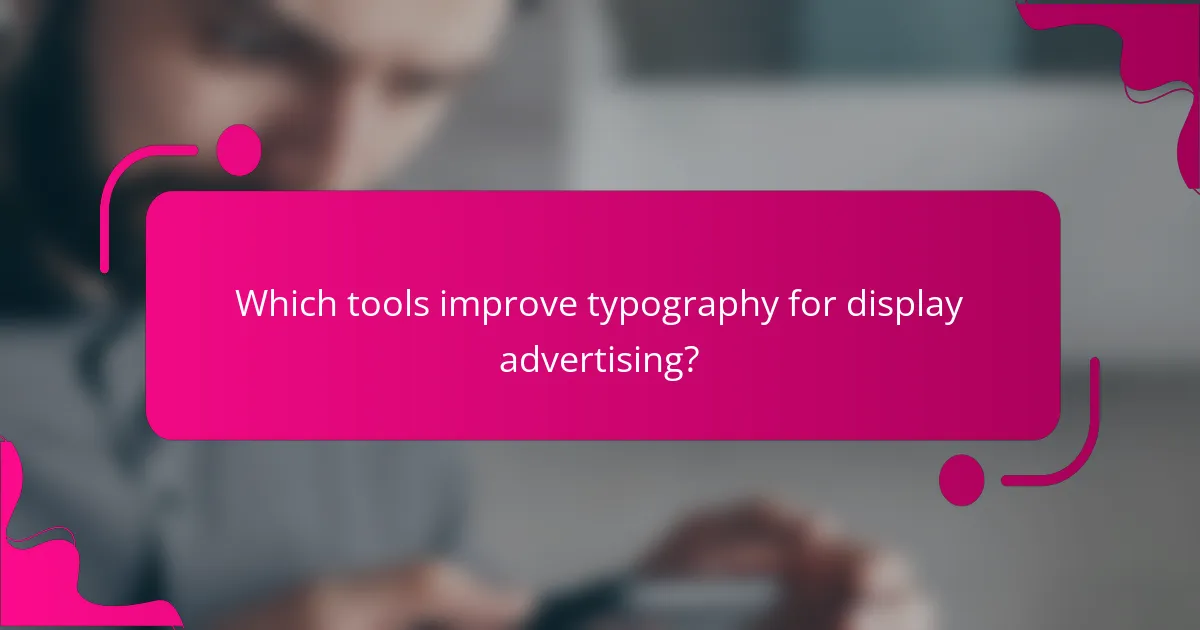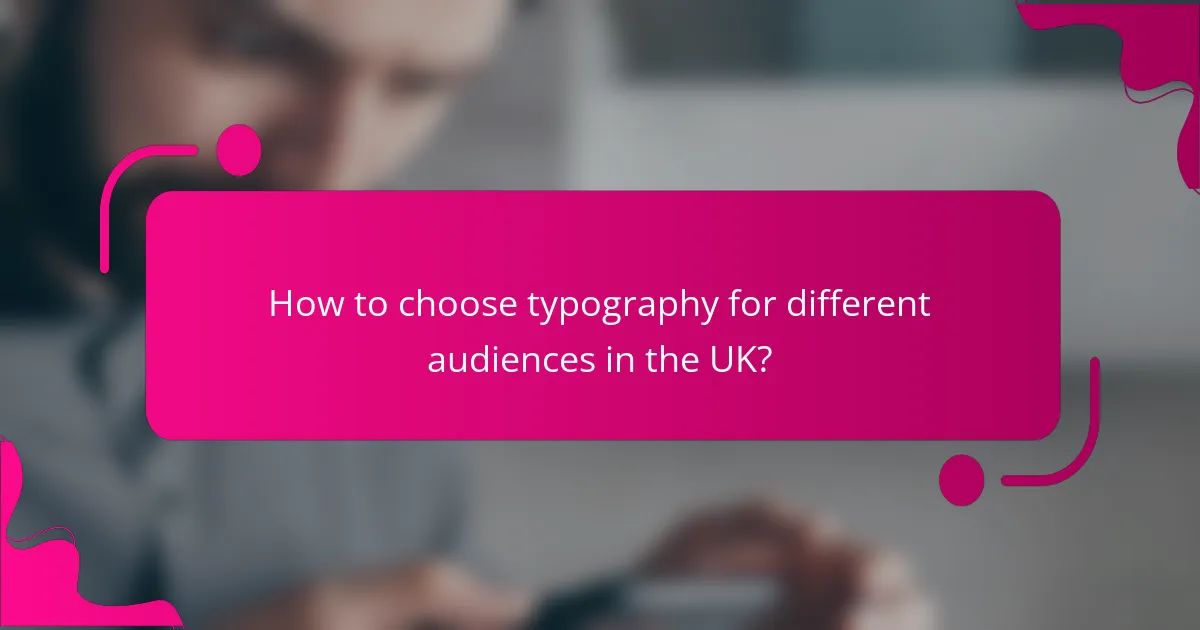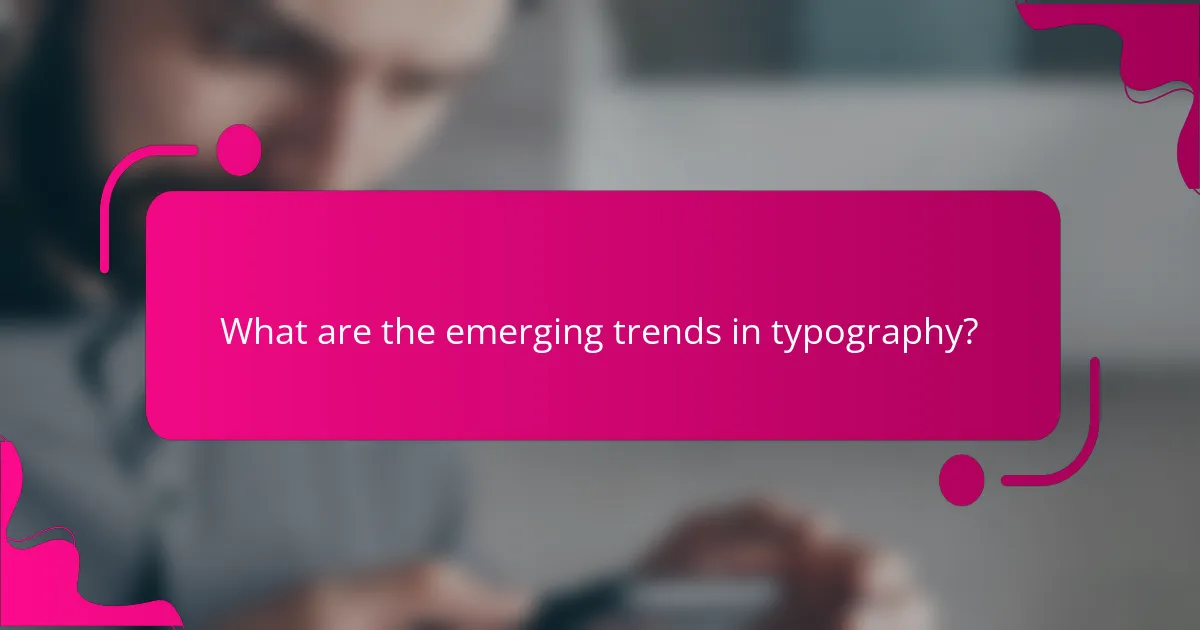Typography plays a crucial role in readability, directly impacting how easily audiences can engage with text. In a diverse city like London, selecting the right fonts not only enhances comprehension but also reinforces brand identity, ensuring a consistent visual experience across various platforms.

How does typography impact readability in London?
Typography significantly affects readability by influencing how easily text can be processed and understood. In London, where diverse audiences engage with various content formats, effective typography can enhance comprehension and user experience.
Font size and line height
Choosing the right font size and line height is crucial for readability. A font size of at least 16 pixels is generally recommended for body text, while line height should be around 1.5 times the font size to create ample space between lines. This spacing helps prevent the text from feeling cramped, making it easier for readers to follow along.
Consider using larger sizes for headings and subheadings to create a clear hierarchy. For instance, headings could range from 20 to 24 pixels, ensuring they stand out and guide the reader through the content effectively.
Contrast and color choices
High contrast between text and background colors enhances readability. For example, black text on a white background is a classic choice that works well in London’s diverse lighting conditions. Avoid using colors that are too similar, as they can strain the eyes and reduce legibility.
When selecting colors, consider accessibility standards, such as the Web Content Accessibility Guidelines (WCAG), which recommend a contrast ratio of at least 4.5:1 for normal text. This ensures that your content is readable for all users, including those with visual impairments.
Spacing and alignment
Proper spacing and alignment contribute to a clean layout that enhances readability. Use consistent margins and padding to create breathing room around text blocks. Left-aligned text is often easier to read than justified text, as it creates uneven spacing that can disrupt the flow.
Additionally, consider using bullet points or numbered lists to break up dense information. This format allows readers to scan content quickly, making it easier to digest key points without feeling overwhelmed.

What typography styles enhance brand consistency?
Typography styles that enhance brand consistency include the careful selection of fonts that reflect the brand’s identity and values. Consistent use of these styles across all platforms helps create a cohesive visual experience that resonates with the audience.
Serif vs. sans-serif fonts
Serif fonts have small lines or decorative strokes at the ends of letters, often conveying tradition and reliability, while sans-serif fonts are cleaner and more modern, suggesting simplicity and clarity. Brands should choose between these styles based on their target audience and the message they want to communicate. For instance, a law firm may opt for serif fonts to evoke trust, whereas a tech startup might prefer sans-serif for a contemporary feel.
Brand-specific typefaces
Using a brand-specific typeface can significantly strengthen brand identity by creating a unique visual signature. Custom typefaces or modified existing fonts can help differentiate a brand in a crowded market. When developing a brand-specific typeface, ensure it aligns with the overall brand personality and is versatile enough for various applications, from digital to print.
Hierarchy and visual structure
Establishing a clear hierarchy and visual structure through typography helps guide the reader’s attention and improves readability. Use variations in font size, weight, and style to differentiate headings, subheadings, and body text. A common practice is to use larger, bolder fonts for titles and smaller, lighter fonts for body text, ensuring that the most important information stands out.

Which tools improve typography for display advertising?
Several tools can significantly enhance typography for display advertising, focusing on font selection, style consistency, and readability. Utilizing these tools can help create visually appealing ads that effectively communicate the brand message.
Adobe Fonts
Adobe Fonts offers a vast library of high-quality typefaces that can be integrated seamlessly into various design projects. Users can access thousands of fonts, which can be filtered by style, weight, and classification, making it easier to find the perfect match for any display ad.
One key advantage of Adobe Fonts is its ability to sync fonts across devices, ensuring brand consistency in typography. Additionally, it supports web fonts, allowing for smooth integration into online advertising campaigns.
Google Fonts
Google Fonts provides a free, extensive collection of open-source fonts that are easy to implement in web design. With hundreds of font families available, advertisers can choose from a wide range of styles to enhance their display ads.
Google Fonts is particularly beneficial for web-based advertising due to its fast loading times and compatibility with various platforms. The service allows users to customize font weights and styles, ensuring that typography aligns with brand identity while maintaining readability.
Canva typography features
Canva includes a user-friendly interface with built-in typography features that simplify the design process for display advertising. Users can easily select from a variety of fonts, adjust sizes, and apply effects like bold or italic to enhance text visibility.
Additionally, Canva allows for the combination of multiple fonts within a single design, which can create a dynamic visual hierarchy. However, it’s essential to maintain consistency in font choices to avoid clutter and ensure brand coherence across advertising materials.

What are the best practices for typography in web design?
Best practices for typography in web design focus on enhancing readability, ensuring accessibility, and maintaining brand consistency. Effective typography not only improves user experience but also reinforces the identity of the brand through careful selection of fonts, sizes, and styles.
Responsive typography
Responsive typography adjusts text size and layout based on the user’s device and screen size. This ensures that content remains legible and visually appealing across various platforms, from mobile phones to large desktop monitors. Use relative units like ’em’ or ‘rem’ instead of fixed units like pixels to facilitate fluid scaling.
Consider implementing CSS media queries to change font sizes at different breakpoints. For example, a base font size of 16px can be increased to 18px on larger screens, improving readability without overwhelming the user.
Accessibility considerations
Accessibility in typography means ensuring that all users, including those with visual impairments, can read and understand content easily. Use high-contrast color combinations, such as dark text on a light background, and avoid overly decorative fonts that may hinder comprehension.
Following the Web Content Accessibility Guidelines (WCAG) is crucial. Aim for a minimum font size of 16px and ensure that line spacing is adequate, typically 1.5 times the font size, to enhance readability for users with dyslexia or other reading difficulties.
Consistency across platforms
Maintaining typography consistency across platforms reinforces brand identity and enhances user trust. Use the same font families, sizes, and styles throughout your website and other digital channels, such as social media and email newsletters.
Establish a style guide that outlines typography rules, including font choices, hierarchy, and spacing. This guide should be accessible to all team members involved in content creation, ensuring that everyone adheres to the same standards for a cohesive brand presentation.

How to choose typography for different audiences in the UK?
Selecting typography for various audiences in the UK involves understanding their preferences and cultural contexts. Consider factors such as age, profession, and regional characteristics to ensure your typography resonates effectively with your target demographic.
Demographic considerations
Demographics play a crucial role in typography selection. For instance, younger audiences may prefer modern, sans-serif fonts that convey a sense of innovation, while older demographics might gravitate towards classic serif fonts that evoke tradition and reliability. Tailoring your font choices to the age and lifestyle of your audience can enhance engagement.
Additionally, consider the profession of your audience. Corporate clients may respond better to clean, professional fonts, while creative industries might appreciate more artistic or unconventional typefaces. Understanding these nuances can guide your typography decisions.
Cultural relevance of fonts
Cultural context significantly influences font perception in the UK. Certain fonts may carry connotations that resonate differently across various regions or communities. For example, a font that is seen as playful in one area might be viewed as unprofessional in another.
When selecting typography, research the cultural associations of specific typefaces. Fonts that reflect local heritage or contemporary trends can create a stronger connection with your audience. This relevance can enhance brand loyalty and recognition.
Industry-specific styles
Different industries often have established typographic norms that can guide your choices. For example, the tech industry typically favors sleek, modern fonts that suggest innovation, while the legal sector often opts for traditional, authoritative typefaces that convey trustworthiness.
To align with industry standards, analyze competitors’ typography and identify common styles. Striking a balance between uniqueness and familiarity can help your brand stand out while still fitting within the expected visual language of your sector.

What are the emerging trends in typography?
Emerging trends in typography focus on enhancing readability, creating unique styles, and ensuring brand consistency across digital platforms. Designers are increasingly adopting variable fonts, bold color contrasts, and minimalistic approaches to improve user experience and engagement.
Variable Fonts
Variable fonts allow multiple styles within a single font file, offering flexibility in design without sacrificing performance. This trend enables designers to adjust weight, width, and slant dynamically, which can enhance responsiveness across different devices.
For practical application, consider using variable fonts to create a cohesive look while reducing load times. Popular variable font options include Google Fonts, which provide a range of styles suitable for various projects.
Bold Color Contrasts
Bold color contrasts in typography can significantly improve readability and visual appeal. Using high-contrast color combinations, such as dark text on a light background or vice versa, helps ensure that text stands out and is easy to read.
When implementing color contrasts, aim for combinations that comply with accessibility standards, such as WCAG, to cater to all users. Tools like contrast checkers can help verify that your choices meet these guidelines.
Minimalistic Design
Minimalistic design emphasizes simplicity and clarity, often featuring ample white space and limited text. This approach can enhance user focus and improve overall readability, making it easier for users to navigate content.
To adopt minimalism effectively, prioritize essential information and use typography that complements the overall design. Avoid cluttering pages with excessive fonts or styles, and ensure that your typography aligns with your brand identity.
Responsive Typography
Responsive typography adjusts font sizes and styles based on screen size and resolution, ensuring optimal readability across devices. This trend is crucial as users access content from various platforms, including smartphones, tablets, and desktops.
To implement responsive typography, use CSS techniques like media queries to define different font sizes for various screen widths. This practice helps maintain readability and enhances user experience on all devices.
